Camelopardalis constellation lies in the northern hemisphere. Its name comes from the Latin derivation of the Greek word for “giraffe.”
Taken apart, the word camelopardalis means camel (Greek kamēlos) and leopard (pardalis). The giraffe was called the “camel-leopard” because it had a long neck like a camel and a body with spots, like a leopard.
The constellation was created by the Dutch astronomer Petrus Plancius and documented by the German astronomer Jakob Bartsch in 1624. It contains Kemble’s Cascade, an asterism formed by a cascade of relatively faint stars, and several notable deep sky objects: the open cluster NGC 1502, the Oyster Nebula (NGC 1501), the spiral galaxies NGC 2403 and IC 342 (the Hidden Galaxy), and the dwarf irregular galaxy NGC 1569.
Facts, location and map
Camelopardalis is the 18th largest constellation in the night sky, occupying an area of 757 square degrees. It is located in the second quadrant of the northern hemisphere (NQ2) and can be seen at latitudes between +90° and -10°. The neighboring constellations are Auriga, Cassiopeia, Cepheus, Draco, Lynx, Perseus, Ursa Major, and Ursa Minor.
The constellation name Camelopardalis is pronounced /kəˌmɛloʊˈpɑːrdəlɪs/. In English, the constellation is known as the Giraffe. The genitive form of Camelopardalis, used in star names, is Camelopardalis (pronunciation: /kəˌmɛloʊˈpɑːrdəlɪs/). The three-letter abbreviation, adopted by the International Astronomical Union (IAU) in 1922, is Cam.
Camelopardalis belongs to the Ursa Major family of constellations, along with Boötes, Canes Venatici, Coma Berenices, Corona Borealis, Draco, Leo Minor, Lynx, Ursa Major, and Ursa Minor.
Camelopardalis has three stars with known planets and no Messier objects. The brightest star in the constellation is Beta Camelopardalis. The October Camelopardalids are the only meteor shower associated with the constellation.
Camelopardalis contains two formally named stars. The star names approved by the International Astronomical Union (IAU) are Mago and Tonatiuh.
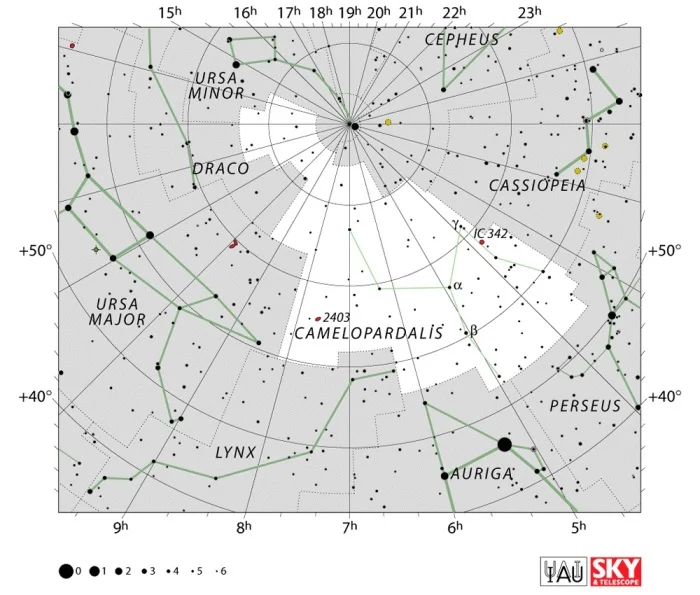
Camelopardalis constellation map by IAU and Sky&Telescope magazine
Story
The Giraffe constellation is pretty faint, with no stars brighter than fourth magnitude. The Greeks did not see any stars in Camelopardalis and thought this region of the sky, as well as what is now the constellation Lynx, was empty. There are no myths associated with the constellation as it was only created in the 17th century.
While the giraffe is not a reference to mythology, the constellation’s name could be a reference to the book of Genesis in the Bible, but this remains doubtful. When Jacob Bartsch included Camelopardalis on his star map of 1624, he described the constellation as a camel on which Rebecca rode into Canaan, where she was to marry Isaac. Since Camelopardalis represents a giraffe and not a camel, this explanation does not seem likely.
Camelopardalis stars
β Camelopardalis (Beta Camelopardalis)
Beta Camelopardalis is the brightest star in the constellation. It is a binary star with a yellow G-type supergiant for the primary component. It is approximately 1,000 light years distant and has an apparent magnitude of 4.03.
CS Camelopardalis
CS Camelopardalis, the second brightest star in Camelopardalis, is also a binary. It consists of a blue-white B-type supergiant and a magnitude 8.7 star located 2.9 arc seconds away. The star is located in the reflection nebula vdB 14.
CS Camelopardalis A is an Alpha Cygni type variable star, one that exhibits non-radial pulsations (which means that some portions of the star’s surface expand while others contract), with luminosity varying from magnitude 4.19 to 4.23. The star is approximately 3,000 light years distant.
Σ 1694 Camelopardalis (Sigma 1694 Camelopardalis, Struve 1694)
Sigma 1694 Camelopardalis, or Struve 1694, is a binary star composed of a white A-type subgiant with a magnitude of 5.3, 300 light years from Earth, and a spectroscopic binary that consists of two A-type main sequence stars. Struve 1694 represents the head of the giraffe.
VZ Camelopardalis
VZ Camelopardalis is an M-type red giant approximately 470 light years distant. It is a semi-regular variable star with a mean apparent magnitude of 4.92. Its luminosity varies from 4.80 to 4.96 with a period of 23.7 days.
Asterisms
Kemble’s Cascade
Kemble’s Cascade is an asterism formed by more than 20 stars between magnitude 5 and 10 that form a straight line in the sky. The line stretches over a distance of five moon diameters and ends at an open star cluster, NGC 1502.
The asterism was named after Father Lucian J. Kemble, a Franciscan Friar who discovered it and wrote a letter to Walter Scott Houston (columnist for Sky and Telescope magazine) describing the sight as “a beautiful cascade of faint stars tumbling from the northwest down to the open cluster NGC 1502.” Houston named the asterism Kemble’s Cascade in his “Deep Sky Wonders” column in Sky and Telescope in 1980.
Deep sky objects in Camelopardalis
NGC 2403 (Caldwell 7)
NGC 2403 is an intermediate spiral galaxy approximately 8 million light years distant. The galaxy has an apparent magnitude of 8.9 and was first discovered in the 18th century by the German-born British astronomer Frederick William Herschel.
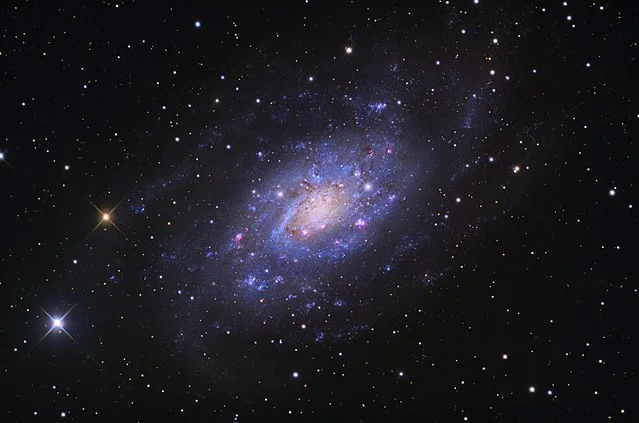
NGC 2403, image: Adam Block/Mount Lemmon SkyCenter/University of Arizona (CC BY-SA 4.0)
The northern spiral arm of NGC 2403 connects to NGC 2404, a nebulous region in an external galaxy, also located in the constellation Camelopardalis.
The galaxy is an outlying member of the M81 Group, a group of galaxies, including M81 and M82, located in the constellation Ursa Major. The group lies within the Virgo Supercluster.
NGC 2403 was the first galaxy discovered beyond our local group that contained known Cepheid variables. Two supernovae were also reported in the galaxy in the last century: SN 1954J and SN 2004dj.
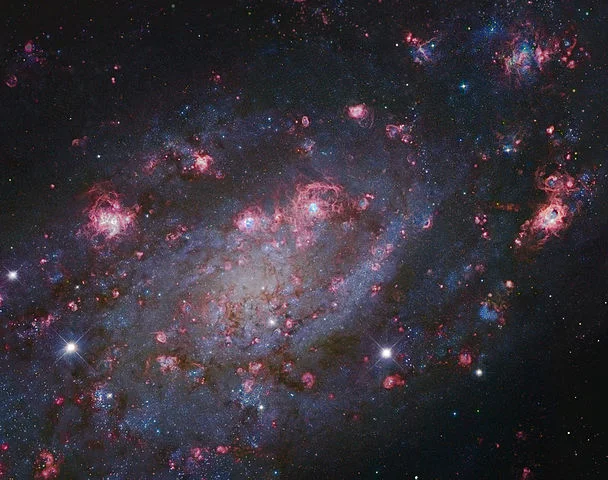
NGC 2403, image Data – Subaru Telescope (NAOJ), Hubble Legacy Archive; processing – Robert Gendler
NGC 1502
NGC 1502 is an open cluster located at the end of the Kemble’s Cascade asterism. It is a small cluster, containing about 45 stars, with Struve 485, a bright binary star, at the centre.
NGC 2366
NGC 2366 is an irregular galaxy with an apparent magnitude of 11.4. The galaxy contains a star forming region, NGC 2363.
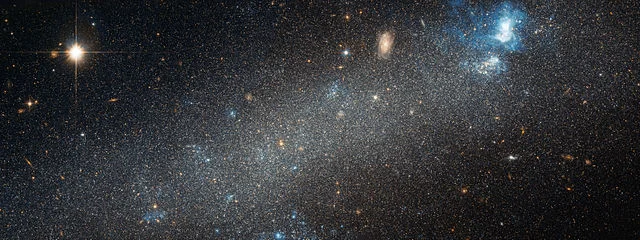
The NASA/ESA Hubble Space Telescope has made detailed observations of the dwarf galaxy NGC 2366. While it lacks the elegant spiral arms of many larger galaxies, NGC 2366 is home to a bright, star-forming nebula and is close enough for astronomers to discern its individual stars. The starry mist streaking across this image obtained by the NASA/ESA Hubble Space Telescope is the central part of the dwarf galaxy known as NGC 2366. The most obvious feature in this galaxy is a large nebula visible in the upper-right part of the image, an object listed just a few entries prior in the New General Catalogue as NGC 2363. A nearby yellowish swirl is not in fact part of the nebula. It is a spiral galaxy much further away, whose light is shining right through NGC 2366. This is possible because galaxies are not solid objects. While we see the stars because they shine brightly, galaxies are overwhelmingly made up of the empty space between them. Hubble’s high-resolution image illustrates this perfectly: the stars are small points of light surrounded by the darkness of space. Image: NASA & ESA
NGC 1569
NGC 1569 is a dwarf irregular galaxy with an apparent magnitude of 11.9. It is approximately 11 million light years distant. The galaxy is notable for the two super star clusters which it contains.
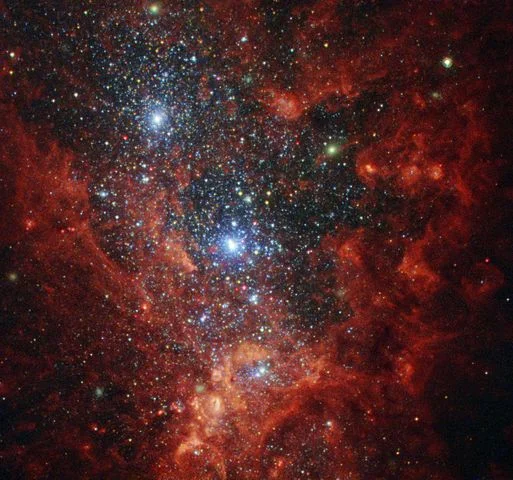
This NASA/ESA Hubble Space Telescope image reveals the iridescent interior of one of the most active galaxies in our local neighbourhood — NGC 1569, a small galaxy located about eleven million light-years away in the constellation of Camelopardalis (The Giraffe). This galaxy is currently a hotbed of vigorous star formation. NGC 1569 is a starburst galaxy, meaning that — as the name suggests — it is bursting at the seams with stars, and is currently producing them at a rate far higher than that observed in most other galaxies. For almost 100 million years, NGC 1569 has pumped out stars over 100 times faster than the Milky Way! As a result, this glittering galaxy is home to super star clusters, three of which are visible in this image — one of the two bright clusters is actually the superposition of two massive clusters. Each containing more than a million stars, these brilliant blue clusters reside within a large cavity of gas carved out by multiple supernovae, the energetic remnants of massive stars. Image: ESA/Hubble & NASA, Aloisi, Ford. Acknowledgement: Judy Schmidt (Geckzilla)
Both clusters have had star forming activity but, while one cluster (located in the northwest region of the galaxy) mostly contains young stars, ones formed less than 5 million years ago, but also some older red stars, the other cluster (located near the galaxy’s centre) contains mostly old stars; red giants and supergiants.
Hidden Galaxy – IC 342 (Caldwell 5)
IC 342 is another intermediate spiral galaxy in the constellation Camelopardalis. It has an apparent magnitude of 9.1 and is approximately 10.7 million light years distant. The galaxy was discovered in 1895 by the British astronomer William Frederick Denning.
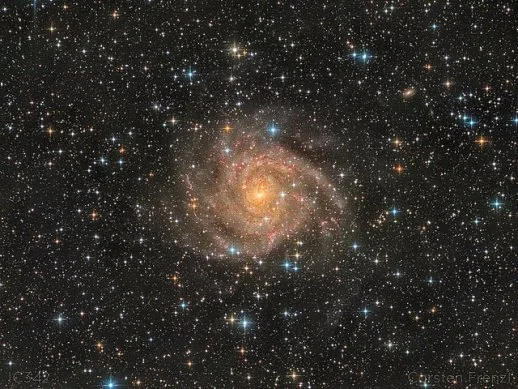
IC 342, image: Carsten Frenzl (CC BY 2.0)
IC 342 lies outside the Local Group of galaxies. It is one of the two brightest galaxies in the IC 342/Maffei Group, the nearest group of galaxies to the Local Group, with most member galaxies concentrated either around IC 342 or Maffei 1, an elliptical galaxy in the constellation Cassiopeia.
IC 342 lies close to the galactic equator and is obscured by a lot of interstellar dust, which makes it a difficult object to observe. This has earned it the nickname the Hidden Galaxy.